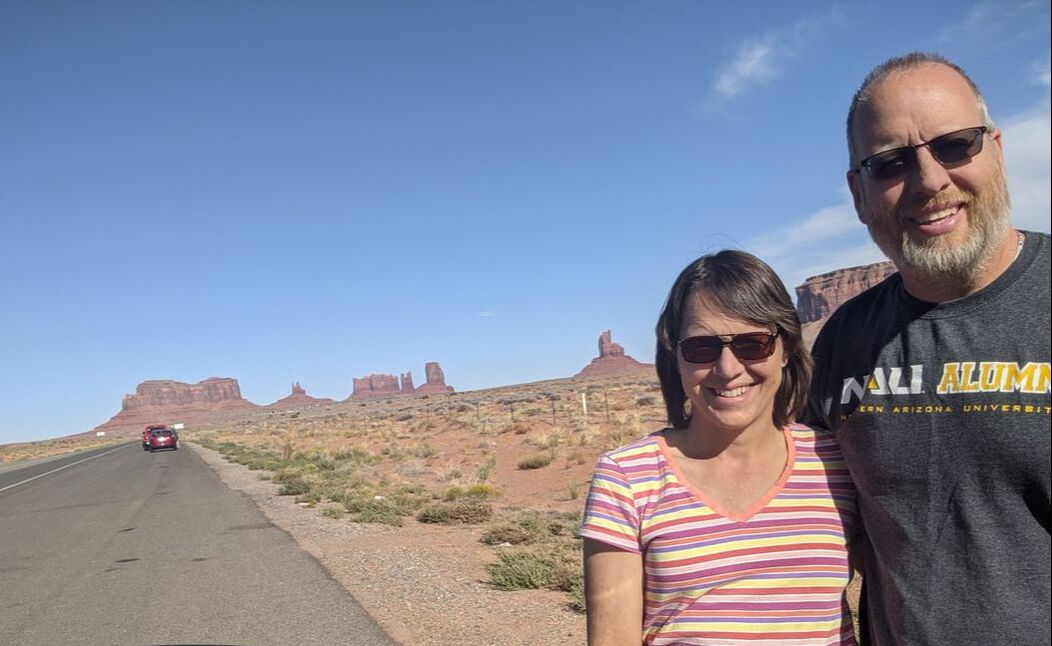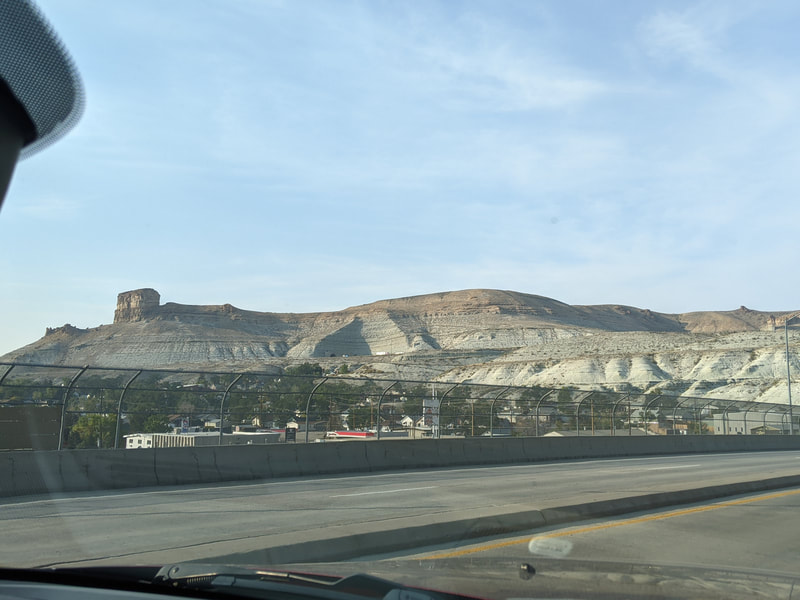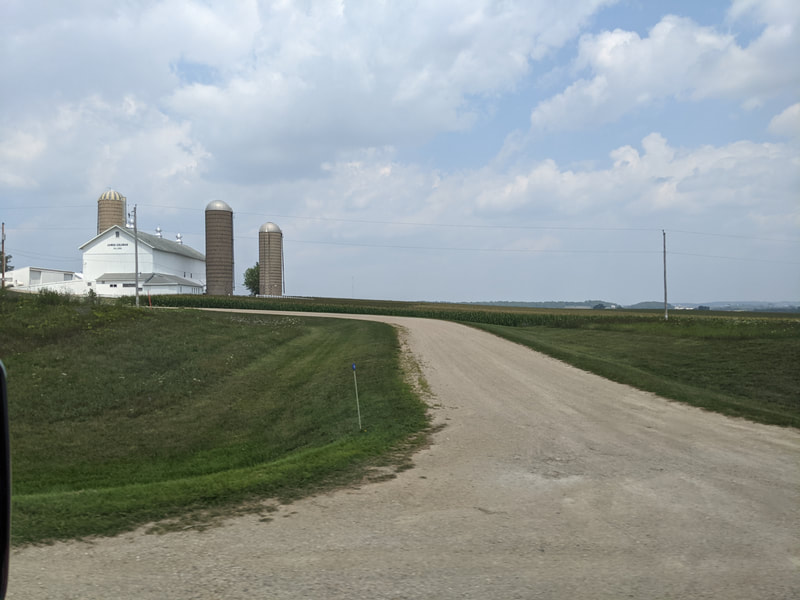|
Our RV travels have afforded us lots of beautiful scenery and landscapes, from deserts and caverns to ranches and farmlands to forests, lakes, and prairies. One thing we don’t tend to see a lot of is rock formations — well, at least we hadn’t until our trek west. Fellow full-time RVer family members Tom and Molly met us in Iowa, and we formed a caravan. They had boondocked in picturesque areas before, and we welcomed their experience as the only other boondocking we had done had been with them. Badlands National Park Named “bad lands” in both Lakotan and French for its difficulty to cross, Badlands National Park near Rapid City, South Dakota, stretches across 244,000 acres and houses some of the most unique geological formations you might ever see. Driving through the park — which you can do in about an hour without stopping — can leave you feeling as if you’re in a dystopian or apocalyptic movie set. Jagged limestone and sandstone peaks rise from the ground, lined with browns and pinks. As you keep driving, you come across some yellow mounds, strikingly different from the other rock formations as they’re rounded and display yellows, greens, and pinks. The extraordinary landscape draws 1 million visitors per year, and it offers much in return. You can spend hours there photographing the landscape, hiking, seeing the scenery change as the sun hits it differently, and watching the wildlife. Bison, bighorn sheep, pronghorns, and prairie dogs roam the area — and seemingly pose for photographs to make your visit that much more rewarding. Mount Rushmore While boondocking near the Badlands, we couldn’t pass up the opportunity to visit the landmark that gives South Dakota its identity as the Mount Rushmore State. The presidents etched in this iconic monument represent the country’s birth, growth, development, and preservation. It took 14 years to complete and is quite a sight to behold. An avenue of flags leads visitors to the viewing area and amphitheater for a closer look at the granite sculpture. You’ll find flags for all 50 United States, the District of Columbia, and the U.S. territories and commonwealths of American Samoa, Guam, the Northern Mariana Islands, Puerto Rico, and the Virgin Islands. We would have liked to have visited the Sculptor’s Studio while we were there to learn more about the creation of the monument, but it was closed at that time. Wyoming As our caravan ventured farther west, the plains of Wyoming gave way to more rock formations. We boondocked on a mountain near Rock Springs, where we had an expansive view overlooking the city and I-80 below. Getting there took us over the best-maintained dirt road we’ve ever seen and presented various rock formations along the way. Utah Tom and Molly lingered in Wyoming while we traversed south. We decided to avoid the interstates and take the more scenic route. It took us along mountainsides dotted with oranges and reds in acknowledgment of the changing seasons and skirted Utah Lake, where boaters and windsurfers enjoyed their sports in the sun. Staying to the east of the state brought us close to Arches National Park and through the beautiful red rocks of Moab. We spent a night in the small town of Bluff, a jumping-off point for both the Four Corners area and Monument Valley, among other geological wonders. Gulliver led us to scenic Monument Valley, with its rising red-sand formations that left us in awe. God is an amazing artist, and we’re thankful we were able to see such beauty on our journey.
4 Comments
Every summer, Bob and I go on tour with the CAF Airbase Arizona B-25 “Maid in the Shade.” Bob serves as a flight crew chief, and I contribute as a ride coordinator and flight loadmaster. Each tour takes us to various places across the country and even into Canada. This year took Bob to Indiana and Illinois and both of us to Missouri and Oklahoma. But we spent most of our time in Missouri. On every B-25 tour, we work long hours to fulfill the Commemorative Air Force mission to honor, educate, and inspire. When the plane is on the ground, we’re open for tours from 9 a.m. to 6 p.m. On the weekends, we sell rides in the plane in the mornings and then open for static tours on the ground after, again until 6 p.m. It’s a rewarding, completely volunteer effort, and we’re honored to be part of it. This year’s tour brought us many firsts. Steam Locomotive While flying weekend passenger rides in Cape Girardeau, Missouri, Bob and the two pilots spotted a locomotive from the air that caught their attention. The B-25 was built to take out trains and other forms of transportation. In fact, our plane flew 15 bombing missions during WWII, and most of them were to destroy railroad bridges. Upon landing the last passenger flight for that day, Bob and the two pilots hopped into a vehicle and drove off to find the train they had seen. It turned out the Union Pacific Railroad’s Big Boy No. 4014, the world’s largest and most powerful steam locomotive, was on tour through 10 states, and we happened to be in the right place at the right time. The WWII era steam train was one of 25 that could carry up to 56,000 pounds of coal and cruise at up to 80 mph. Starting in 2016, after 55 years of lying dormant, No. 4014 underwent a three-year restoration, including converting it from a steam engine to burn No. 5 fuel oil. Today, it’s the only operational Big Boy left. Amusement Park-Size Store Because of our busy tour schedule, we don’t get a lot of time off. We were blessed to have a window of opportunity to do a little exploring in Springfield, Missouri, the home of Bass Pro Shops. We couldn’t pass up the opportunity to visit the “Granddaddy of All Outdoor Stores,” which houses three museums and a whole lot more — and is in an expansive complex that also includes the Bass Pro Shops Catalog Outlet store. One museum is dedicated to the humble beginnings of the enterprise giant. Another is a rifle museum. But the most prominent is the Wonders of Wildlife National Museum and Aquarium, which features 35,000 live fish, reptiles, mammals, and birds and is said to be larger than the Smithsonian Museum of Natural History. We wanted to tour the wildlife museum but didn’t have the three to fours needed to do it justice, so we’ll have to go back another time with Gulliver and Tagalong when we can explore Branson too. Catching Rolls If you want a truly unique experience in Springfield, you’ll want to head to Lambert’s Cafe. Known as the “home of throwed rolls,” the restaurant provides a rustic experience in a fun atmosphere. Wait staff walk up and down the aisles between tables to dump a spoonful of fried okra on a napkin for you to enjoy. A roll tosser flings hot rolls at anyone who wants them. All you have to do is catch them. Once you order and receive your food, more wait staff traverse the aisles to deliver pass-arounds of fried potatoes, macaroni and cheese, black-eyed peas, and other additions to your plate. Lambert’s motto is “Come hungry, leave full & hopefully have a laugh or two,” and they mean it. We and the rest of our B-25 crew certainly left full. Other Firsts In addition to those extraordinary encounters, we had our first evening flight on the B-25 as we had to dodge bad weather in Cape Girardeau and Springfield. That led to another first: seeing a rainbow from the air. A torrential rainstorm in Springfield trapped us and the rest of the crew in the B-25 trailer, still another first. Fortunately, the guys had secured rain covers on the aircraft just in time. After about a half hour, we were able to escape our shelter and head to our hotel for the evening. Our favorite experience, and the main reason we do what we do with the B-25, was a visit from a WWII veteran who said seeing our plane was “the best day of my life.” Ruben Olson was a heavy equipment mechanic on B-24 Liberators from 1943 to 1945 and gladly shared about his experiences. You’d never guess he’s 96 if you saw him dash up the ladders to see inside the B-25. We’re not sure who was more honored by the encounter: Olson or our crew.
Although we had driven through Iowa a couple of times, we had never spent any time in the state until traveling through in our fifth wheel. Our ignorance about Iowans and Iowa life quickly became apparent. We thought Iowa was nothing but farms for miles and miles and miles. Indeed, as the largest producer of the nation’s corn, it's covered by expansive farms and is sometimes called “The Corn State.” But there’s much more to Iowa than that: a storied past, people with an affinity for old cars, abundant aircraft, and the world’s largest truck stop. Historical Farms Some of Iowa's farms date back hundreds of years. Perhaps one of the most notable is the Amana Colonies, which spans 26,000 acres and is divided into seven villages. A religious sect of Pietists fled persecution in Germany in 1844 and started a commune in Buffalo, New York, where 1,200 people shared all their property and belongings and worked cooperatively. Eleven years later, when they needed more farmland, they moved to Iowa and settled along the Iowa River near Cedar Rapids. The communal ways went by the wayside in 1932 but, wanting to preserve their heritage, residents set up a profit-sharing corporation, the Amana Society Inc., to manage the farmland. Today, the villages welcome visitors and provide a look and feel of what life was like 150 years ago. This is the same Amana behind the appliance company, which started in Middle Amana, Iowa, in 1934 as Amana Refrigerator Inc., a manufacturer of walk-in coolers. Today, the company bears the Whirlpool name. Silos vs. Grain Bins Many, if not most, Iowan farms feature round structures in varying heights, but they’re not all silos that store grain like we thought. Silos tend to be tall and narrow and made of concrete, bricks, or metal. They’re easy to recognize by their dome roof. The shorter, stouter round structures are called grain bins. They’re made of corrugated steel and have peaked roofs. As their name implies, grain bins are used to store grain — most often corn or soybeans. Silos, however, house what’s called “silage”: grass or other green foliage harvested and stored wet. This then ferments and is used to feed cattle. As a result, you’ll most likely see silos on cattle farms. Proud Patriotism In addition to taking pride in their farms, Iowans love their country. The Brooklyn Historical Museum in Brooklyn, Iowa, is evidence. A WWII display has taken over the exhibit about John Wayne, who attended second grade in the area. Research has revealed that a soldier from Brooklyn played a part in raising the American flag atop Mount Suribachi in Iwo Jima — one of the most famous pictures from the war. Although somewhat hidden in the photo, Harold “Pie” Keller has been recognized for his role, and the town couldn’t be more thrilled. Brooklyn is also home to the Avenue of Flags, where the town proudly displays a collection of flags from each of the 50 states, the four branches of the military, and even some other nations. The idea surfaced in 1991 when the city first assembled an avenue of flags to welcome the Register's Annual Great Bicycle Ride Across Iowa riders. The city is raising funds to add a life-size bronze statue of Keller to the avenue. Classic Cars Iowans’ love of America extends to classic automobiles. In one week in the area, I saw three car shows:
I had the privilege of truly immersing myself in history by driving a 1958 Edsel with Teletouch push-button transmission. In the 1950s, car manufacturers started experimenting with alternative ways to shift transmissions. One of the most notable of the time was a push-button solution. Most manufacturers had some version of this, the last of which was Edsel in 1958. The idea was to free visibility to the car’s dashboard. The car may lack power steering and power brakes, but it definitely provides full visibility of the dashboard. And, with no air conditioner, the ingenuity behind the curved windshield and quarter glass vent windows that deflect the wind and prevent hair from blowing impressed me. Appealing Plane Conditions Like Arizona, Iowa is largely a grid state, with roads in straight lines every mile. And, like Arizona, it has a lot of sunny days — about 200 a year. That sunshine and wide visibility are inviting to pilots. Bob and I both got to experience two-seater planes for ourselves while there. Our Iowan hosts, Gene and Ann Adkins, own a 1960 Cessna 150 taildragger. Gene let me fly with him from Grinnell, Iowa, to a little city called Monticello for a fly-in. All kinds of personal aircraft lined the airport ramp as pilots and passengers gathered for a pancake breakfast put on by the Lions Club. When the B-25 WWII bomber we tour with had a maintenance issue that needed to be addressed, fellow Commemorative Air Force member Frantz offered to fly Bob from Grinnell to La Porte, Indiana, in his RV-7. Bob had been scheduled to fly commercially a couple of days later to join the B-25 on tour. With this turn of events, we packed Bob in an hour and sent him on his way the day after we arrived in Iowa, thankful for the private flight blessing. World’s Largest Truck Stop
As the nation’s top corn, pork, and egg producer, Iowa requires a lot of semi-trucks to traverse its highways to deliver these goods to other parts of the country. Perhaps that’s why it’s been home to the World’s Largest Truck Stop since 1964. After 28 expansions and remodels over the years, the Iowa 80 Truck Stop today features space to park 900 trucks, a Super Truck Showroom, a movie theater, laundry facilities, a dentist office, a museum, and a whole lot more. It’s worth stopping to see if you find yourself traveling down Interstate 80. |
AuthorThis is the travel blog of full-time RVers Bob and Lana Gates and our truck, Gulliver, and fifth wheel, Tagalong. Categories
All
Archives
July 2024
|


































 RSS Feed
RSS Feed